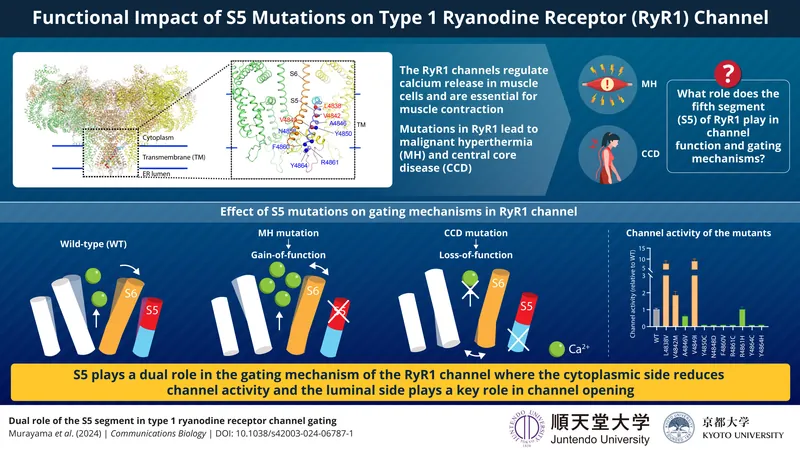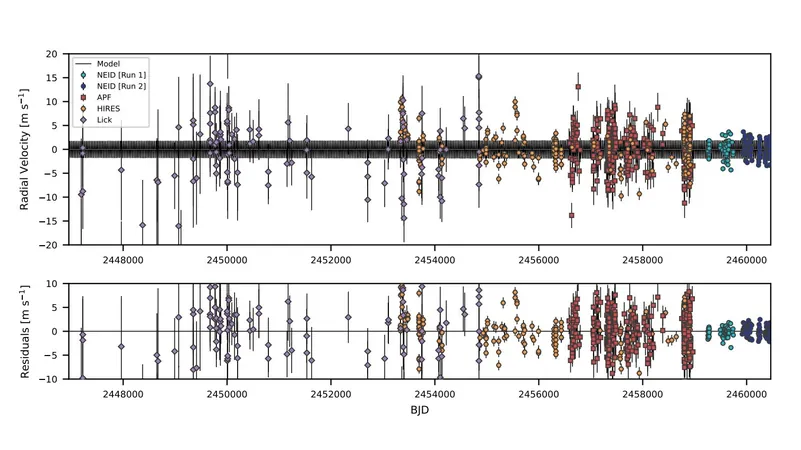
Groundbreaking Discovery: How Mutations in Key Muscle Protein Could Lead to Revolutionary Treatments!
2024-09-18
Groundbreaking Discovery: How Mutations in Key Muscle Protein Could Lead to Revolutionary Treatments!
Scientists have made an astonishing breakthrough in understanding the role of the type 1 ryanodine receptor (RyR1), a vital calcium release channel necessary for muscle contraction. This protein mediates the release of calcium from the sarcoplasmic reticulum, an organelle residing within muscle cells, playing an indispensable role in muscle functionality.
However, not all is well in the world of muscle health. Mutations in the RyR1 gene can have divergent and severe repercussions, resulting in debilitating diseases like malignant hyperthermia (MH) and central core disease (CCD). MH, an inherited condition, causes extreme fever and severe muscle contractions in response to certain anesthetics, particularly in individuals with gain-of-function RyR1 mutations. On the other hand, CCD results in muscle weakness and myopathy, associated with loss-of-function mutations.
Despite previous research highlighting the larger cytoplasmic region of RyR1, the less-explored fifth transmembrane segment (S5) and its role in muscle diseases have remained a mystery—until now. In a pivotal study released on 18 September 2024 in *Communications Biology*, a team of researchers from Japan sought to unveil the secrets behind the S5 segment’s mutations and their contributions to both MH and CCD.
Led by Associate Professor Takashi Murayama from Juntendo University alongside colleagues from Kyoto University, the research team was determined to explore how mutations in the S5 segment could cause serious muscle disorders. “The S5 segment is crucial for pore formation in the RyR1 channel. We were motivated by the numerous disease-associated mutations present in the S5 region described in existing literature,” explained Associate Prof. Murayama.
To investigate, scientists engineered HEK293 cells to express specific RyR1 protein mutations. They meticulously analyzed caffeine-triggered calcium release to see how these mutations impacted calcium dynamics. Furthermore, they monitored resting calcium levels within the cytoplasm and endoplasmic reticulum using advanced fluorescence tools.
Their results were astonishing. The focus was on mutations in the S5 and S5-S6 regions of RyR1, revealing three mutations linked to MH and eight associated with CCD. The MH mutants displayed heightened caffeine sensitivity, elevated resting cytoplasmic calcium levels, and diminished ER calcium levels, indicating overactivity of the channel. Conversely, the CCD mutants showed a marked loss of function, characterized by a decrease in caffeine sensitivity, limited calcium release, and suppressed ryanodine binding.
Furthermore, some CCD mutants exhibited no detectable functionality, even though the proteins were expressed, highlighting a severe impairment in channel performance. These findings were underscored by visualizations crafted by the authors, showcasing the RyR1 channel's structure amidst these mutations.
Delving deeper, the researchers identified significant interactions between the mutated residues and other transmembrane segments of the RyR1 channel, leading to groundbreaking insights into its complex regulatory mechanisms. Associate Prof. Haruo Ogawa remarked, “We discovered a novel regulatory mechanism for RyR1, where the S5 segment has a dual role in channel gating, shedding light on how mutations alter channel function.
With these discoveries, the implications could extend far beyond basic science. The research opens new avenues for the development of innovative therapeutic drugs to treat muscle disorders linked to RyR1 mutations. Associate Profs. Murayama and Ogawa emphasized, “Our findings pave the way for groundbreaking opportunities to create targeted treatments for muscle diseases, potentially transforming lives affected by these debilitating conditions.”
As research continues, it remains pivotal to remain vigilant for further revelations surrounding these muscle disorders—who knows what other secrets the RyR1 channel may hold that could lead to astonishing medical breakthroughs? Stay tuned!



 Brasil (PT)
Brasil (PT)
 Canada (EN)
Canada (EN)
 Chile (ES)
Chile (ES)
 España (ES)
España (ES)
 France (FR)
France (FR)
 Hong Kong (EN)
Hong Kong (EN)
 Italia (IT)
Italia (IT)
 日本 (JA)
日本 (JA)
 Magyarország (HU)
Magyarország (HU)
 Norge (NO)
Norge (NO)
 Polska (PL)
Polska (PL)
 Schweiz (DE)
Schweiz (DE)
 Singapore (EN)
Singapore (EN)
 Sverige (SV)
Sverige (SV)
 Suomi (FI)
Suomi (FI)
 Türkiye (TR)
Türkiye (TR)